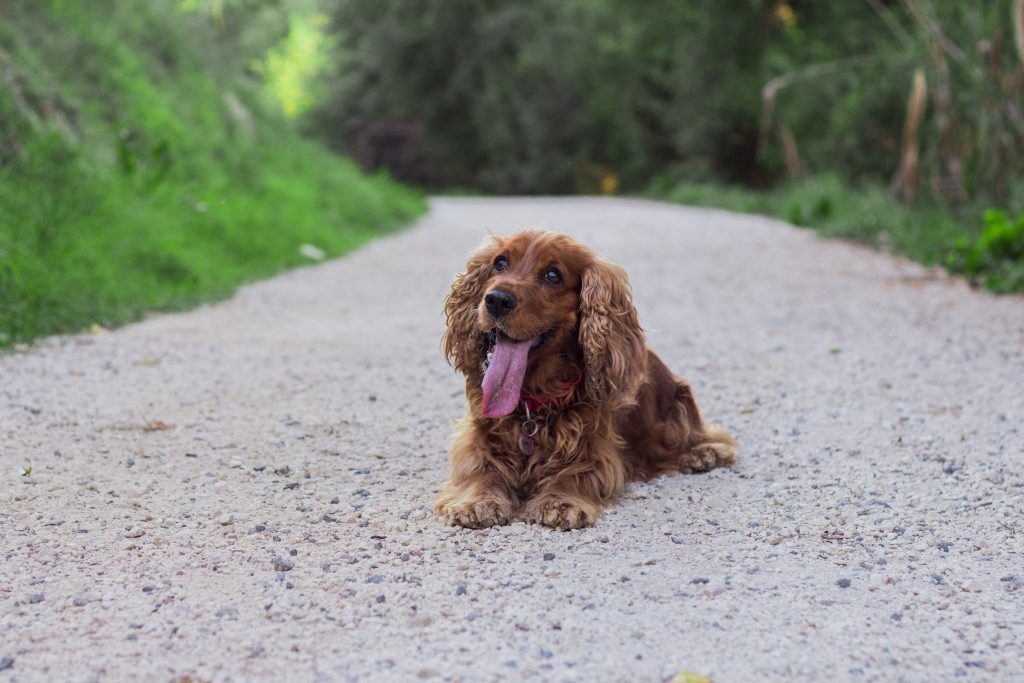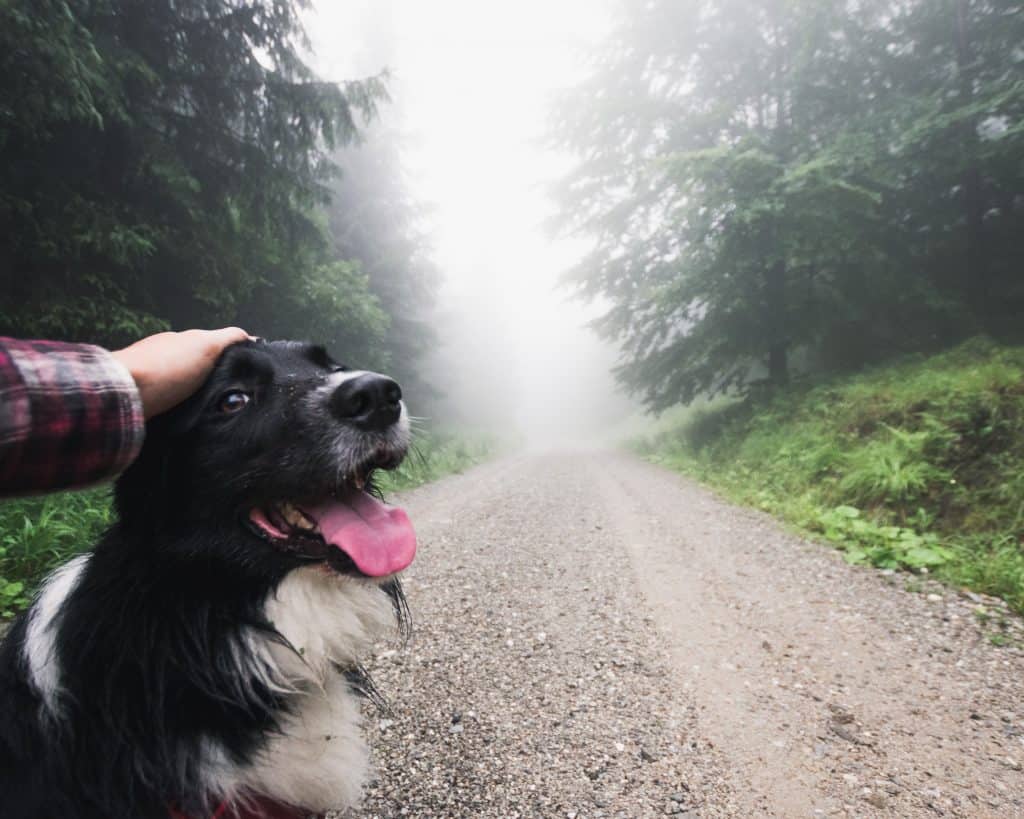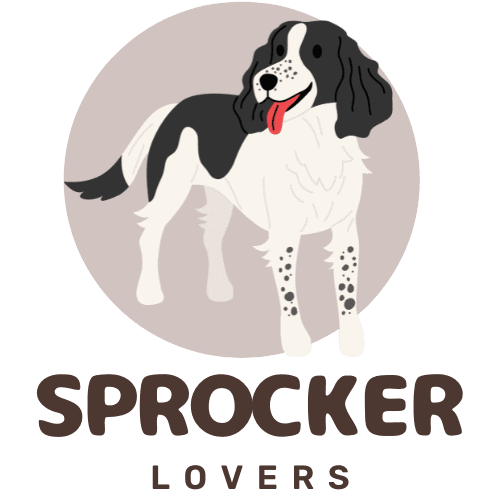Spaniels are excitable, energetic, and love to learn.
A combination of excitement and the constant need for mental stimulation can turn into negative behavior if not managed correctly.
But, if you give your Spaniel training from an early age (especially during the socialisation period), it’s likely that they will also be well-behaved. You won’t need to apologise to friends and family for the puppy jumping all over them–and it could even save your pup’s life if they listen to your commands outside of the house.
So, which training commands should you teach your Spaniel?
Here are 10 super useful Spaniel training commands, with easy guidelines on how to teach your dog to follow each:
This post contains affiliate links. Please read my full disclosure here.

1. Sit
Teaching your Spaniel the “sit” command is useful for many reasons–hence why it’s often the first command any new dog owner teaches.
Having your dog sit down on command helps when you’re opening doors to prevent them from diving in front of you and tripping you over. It’s also a helpful command to use in stopping them from jumping up on people, or trying to wrestle their way to the water bowl (and tipping it over.)
Here’s how to do it:
- Take a treat in your hand and lift it to their nose
- Continue to lift the treat up. As their gaze follows your hand, they will sit naturally
- When they are sitting, say the command “sit” and reward them with the treat
Repeat this training command for a few minutes, giving them lost of rewards and repeating “sit” whenever they get into the correct sitting position. It won’t take long for them to get the hang of it.
2. Lie down
Spaniels are a lively breed, and being able to get your dog to lie down on command can be a fantastic way to calm them down.
This training command comes in handy especially when you’re away from home. Let’s say you’re taking your Spaniel pup to your parent’s house, for example. They’re overwhelmed with all the new scents, and act as if they’re high on the new adventure. Giving the “lie down” command brings their attention back to you, and calms them down.
Here’s how to teach the “lie down” training command:
- Get your dog in the sitting position and hold a treat in your hand in front of them
- Lower your hand to the ground until they are lying down.
- Once they are in the lying position, say “Lie Down” and reward them with the treat and praise.
3. Roll over
The “roll over” training command mainly for fun–both for you and your Spaniel!
Spaniels are an intelligent breed, so a lot of their training commands play a vital role in their mental development and exercise. Teaching them this trick requires lots of focus and attention. Plus, it can also come in handy when you need to get them to roll onto their back to check their belly for any reason.
Explaining how to teach the “roll over” command is is pretty tough in writing. But here’s a simple video for you to follow:
4. Paw (or “Shake”)
For most dog owners, the “paw” command is one of the first tricks they teach their puppy (alongside “sit”).
That’s because this training command is a useful tool in slowing them down. You can also rely on this command if you need to inspect their feet for any reason–such as cutting their nails or checking the condition of their pads. This fun trick desensitises them to having their paws touched, and shows them it’s a good thing. They’ll get a treat afterwards!
To teach your dog to give their paw, follow these steps:
- Hold a treat in one hand.
- Close that hand, but let your dog smell the treat so that they know it’s there.
- Most dogs will lift their paw to try to get to the treat. When they do this, offer the treat to them.
- After they have been able to do this a couple of times, add in the “Paw” command.
Bonus: Add an extra command to this with “Other Paw” which indicates to your dog to lower the paw they have offered to you, and give the other one instead.
5. Wait
The “wait” command is one of the most useful commands you can teach any dog.
It comes in handy in a number of occasions–from telling your dog to wait at the curb before crossing the road, to stopping them from running out of the front door when you open it to sign for a parcel.
Teach your dog how to wait by:
- Asking your dog to sit or lie down.
- When they’re in position, say “stay” in a clear voice whilst holding your hand out with your palm facing them.
- After a few seconds of them remaining in that position, reward them with a treat and lots of praise.
You can gradually increase the length of time that they hold the “wait” position before they receive their reward. You can also start to move further and further away from them so that you can eventually use the command without having to be right next to them.
And, when they’re really good at it, roll a treat across the floor whilst giving the “wait” command. That will teach them to stay still until they’ve been given the all-clear to move–even when there are distractions.

6. Take It
You don’t want a puppy to get into the bad habit of snatching things out of your hand.
The “take it” command can teach your dog that they’re only allowed to take things when you’ve given them permission to do so. (Yes, that does mean your Spaniel will learn to leave a pair of socks on the floor without running off with them!)
Here’s how to teach your dog to “take it”:
- Hold your dog’s favourite toy in your hand and encourage them to grab it.
- As they open their mouth to take hold of the toy, say “take it”, allowing them to have the toy is their reward.
- Once you have repeated this exercise a number of times, you can put the toy somewhere else–like on the floor or in their bed. Ask them to wait or stay and then tell them to take it.
7. Leave It
Soon after bringing home your Spaniel puppy, you’ll notice how much they love carrying things.
(Remember: Spaniels were originally bred to be gundogs. They’d collect things for their owner–such as pheasants or rabbits–and retrieve them back. That’s why they always have something in their mouths.)
But your Spaniel might be carrying something you don’t want them to have, like a sock or pillow. Or, it could be a dangerous object they’ve got hold of that might harm them–such as a dead bird or a dirty sock they’ve sniffed out on a walk.
The “leave it” command can be used to stop them from even picking up the item in the first place.
Start training your dog to “leave it” by:
- Placing a treat on the floor in front of your dog and tell them to “leave it”
- If they are lunging for the treat immediately. (You may want to put them on a lead so that you can hold them back.)
- After a couple of seconds, use your release command (usually “okay” or “free”) to indicate to them that they can get the treat.
- Continue to repeat this process, increasing the time that they have to wait before receiving their reward each time.
Bonus: In addition to “leave it”, you can also teach your Spaniel to “drop it” for those occasions when “leave it” is too late and they already have the item in their mouth.

8. Come or Here
Recall should form a major part of your Spaniel’s training program. Traditionally, as a hunting breed, recall would be one of the biggest parts of their job! And, let’s face it: it’s no fun for your dog to be on their lead whenever they’re walking. They need some freedom to smell, explore, and get lots of running in.
That’s why “come” is an essential command both in the home, and whilst out on walks if your Spaniel is off-lead.
However, recall is one of the trickiest commands to teach. Spaniels have been known to have selective hearing, and it takes a lot of repetition to have a reliable recall command.
You can get started by:
- Choosing a command to use for recall. “Come” and “here” are the most common.
- Use your command word whilst running backwards (facing your dog), and reward them with a treat each time they return to you. This builds the mental connection of the command word and running towards you.
- Practice this a number of times at home or where there are very few distractions until you are confident in your dog’s recall before moving your training outdoors.
If you’re struggling with your Spaniel’s recall, I highly recommend the Total Recall book.
Bonus: Use the command “touch it” to indicate to your dog that they should return to you and touch their nose to your hand. This is a great command for dogs who return close to you but not close enough for you to catch them or put their lead back on with the “Come” command.
9. Bed or Crate
Does your Spaniel sleep in a crate overnight?
Teaching them to go to bed is a great command for helping to calm down your dog when they get over-excited, or if they sleep in a crate overnight. You don’t need to pick up your dog and put them in a crate; this command encourages them to go in their crate on their own accord.
For this training command, you will need to have your dog on their lead. Then:
- Hold the lead in one hand and a treat in the other hand.
- Lead your dog to their bed or crate with the treat in front of them.
- When they get on their bed or in their crate, say your chosen command and reward them with the treat.
- Repeat this a number of times before trying without their lead on.
10. Heel
If they’re not trained to walk nicely, Spaniels can pull like a steam train.
(Take it from me. My Sprocker, Hugo, almost broke my back every time I walked him as a puppy.)
You can teach your dog to stop pulling on their lead when you’re out walking by using the “heel” command. Not only will this make your daily dog walks more pleasant, but it’s a good way to stop your dog from lunging at other dogs who may be passing by.
Training your Spaniel to walk to heel involves holding the lead in both hands to prevent them from pulling and walking slowly with them next to you whilst using the command “heel” in a firm voice.
Check out this video on teaching your dog to walk to heel:
Which training command does your Spaniel know?
As you can see, there are several training commands you’ll need to teach your puppy.
They’ll come in handy in tons of real-life situations–like waiting for you to open the door, to coming back when they’re playing off-lead.
But, the good news is that Spaniels are extremely easy to train.
Their gundog history and constant need for mental stimulation means they love learning new tricks. Plus, once you’ve taught them the initial command, a few training sessions each week will make sure they’re not rusty in situations you need a reliable command for.


